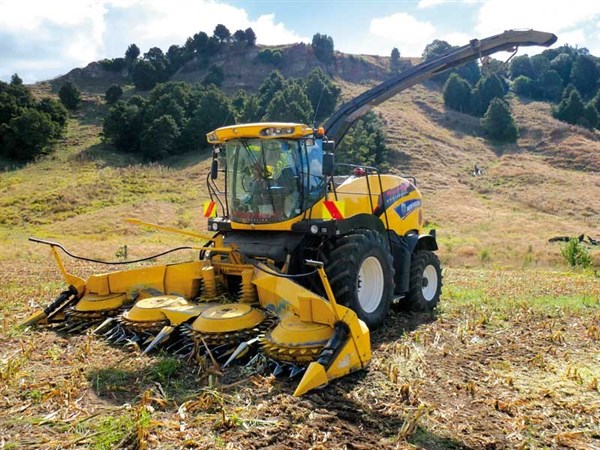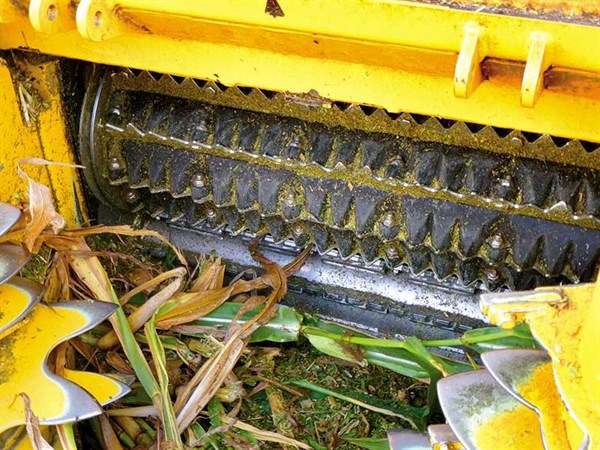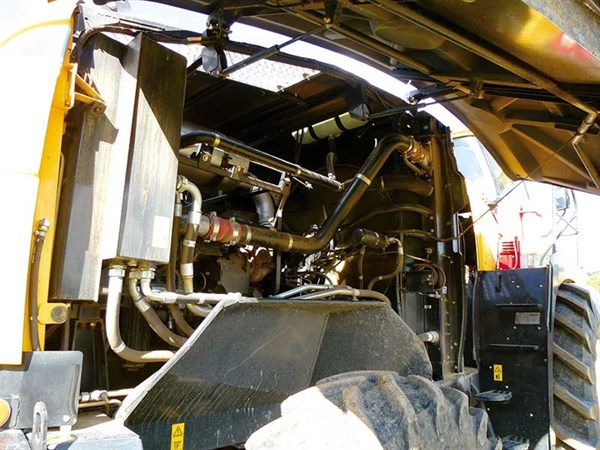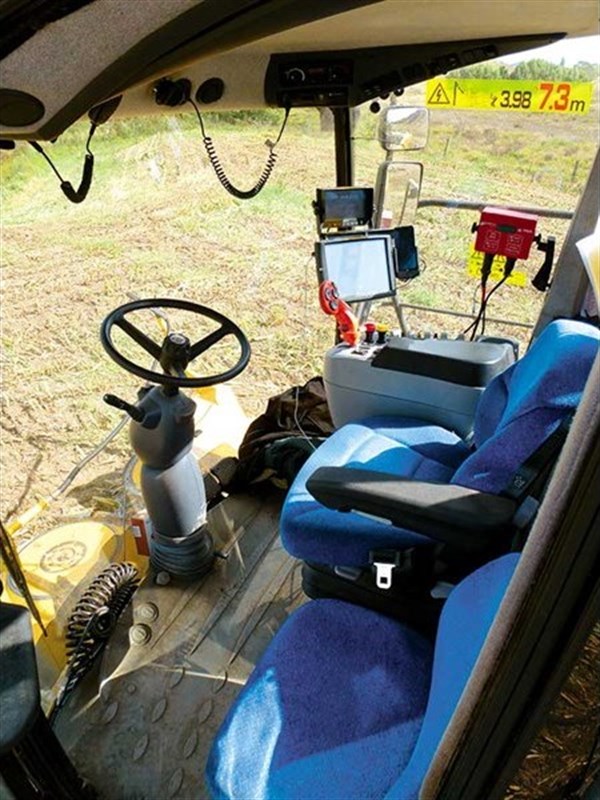Even having spent a substantial amount of time in forage harvesters here and around the world, New Zealand reviewer BRENT LILLEY is still impressed watching a machine chomp through a crop of maize.
The sound is unmistakeable. The power and engineering involved in getting eight rows of standing maize chopped into pieces and then passed through a processer to crush the kernels is phenomenal.
Without getting too nostalgic, some years ago I was working my way around the United Kingdom when I landed a job with a contractor driving what was then one of the first of the new FR model forage harvesters in the country at the time.
For me, the opportunity to check out the first of the newly released updated FR models to appear in New Zealand is definitely too good to pass up. I am keen to see what improvements have been made to what was already a well-rounded machine.
The New Holland FR600
The New Holland FR600 harvester is owned by Dean Parkes of Parkes Contracting, which operates from near Te Awamutu in the Waikato.
It arrived last September to replace an FR9060 and when I caught up with it in the middle of their busy maize season, it was closing in on 2,000 hectares of work.
Parkes is stoked with the new machine. He has seen some definite improvements on the preceding.
Feed rollers
Feed rollers serve two important purposes. First they compress the crop into a uniform mat to ensure precise cutting and second they feed the crop in at an even speed to produce uniform chop length.
New Holland has the widest feed rollers and chopping cylinder on the market and this means material is fed to the cutting cylinder in a wider thinner mat, which along with the HydroLoc drive system produces a precise uniform feeding and therefore length of chop.
One improvement from the earlier model I am pleased to see is more plates and guards around the feed rollers, which keep material in the feed channel and prevent excess build up around the front of the machine.
The HydroLoc system uses a hydraulic motor to drive the gear box on the feed rollers and power them separately of the cutting cylinder.
This drive setup means the speed of the feed rollers and therefore the length of chop is infinitely variable from the cab.
Double drive, an option fitted on Parkes’s machine, uses an additional hydraulic drive motor to drive the header.
This increases the power to the header and prevents it from slowing the feed rollers down in heavy crops. It also allows the speed of the header and the speed of the feed rollers (chop length) to be varied independently and infinitely.
MetaLoc metal detection system
Metal detectors are a must on a modern chopper and the problem with finding metal in the crop is that when it is detected it usually falls on the trailer driver beside the machine.
New Holland has again come up with some clever ideas to make the process as easy as possible.
The feed rollers are divided into six separate detection zones and I’m told the MetaLoc system will bring the feed rollers to a halt in 0.003 seconds of detection with the help of the HydroLoc gearbox.
The monitor in the cab then displays which section the detection is in, making it easier to find the metal across the wider width.
To show the trailer driver where the metal is on the feed rollers, the indicators are set up to flash the number of times to correspond to the zone where the metal is, from one to six.
In my own experience it is easier and quicker to point out where the metal is than trailer drivers trying to count the number of times the indicators flash.
Cutting cylinder
The cutting cylinder is definitely the business end of the machine. Spinning at more than 1,000rpm it can chew through a serious amount of material in a hurry.
Not only does the New Holland have the widest chopping cylinder on the market at 884mm wide, but the whole feed channel from the feed rollers through the cutting cylinder and processer to the accelerator is also widened to enable the machine to process a larger quantity of material.
Each knife is held to the cylinder with five bolts for safety. They are arranged in a chevron pattern for a smooth efficient scissor-like cutting action against the shear bar.
There is an option for 12, 16 or even 20 knives each side of the cylinder. At more than 600kg, the New Holland cutting cylinder is also the heaviest available offering high inertia to prevent shock loads and gives the most uniform chop length.
New Holland has offered forward or reverse sharpening as an option for some time. It is a relatively simple set-up with a hydraulic motor that simply turns the chopping cylinder in reverse before the sharpening cycle starts and the stone is drawn across the top of the cylinder.
As you’d expect these days, the sharpening and shear bar setting processes are carried out from the cab and are adjustable.
model and reports a largely trouble free run with it so far.
Engine
The FR600 model sits in the middle of the range that starts at 450hp (335kW) with five models up tothe top 850hp (633kW) monster.
The engine is mounted longitudinally in the back of the machine over the rear axle and is a sizable inline 6 cylinder 12.9-litre FPT (Fiat Power Train) engine which is combined with a compound turbo to develop 600hp (447kW).
The engine delivers smooth power on demand and the compound turbo setup is said to decrease fuel consumption by around eight percent.
Access to the engine has been improved with massive single piece rear and side panels that open up on gas struts to give all round access.
An update from the first FR models is a two stage throttle. Push the engine rpm button once to go from an idle up to 1,850rpm then once more to full noise.
Although a little unnerving to begin with, the option of 1,850rpm is great, as this is where the maximum power out of the engine is.
It means that any time the engine is running at less than full capacity (i.e. headlands and areas of light crop), it is using less fuel and as the load on the engine increases, it still increases its power to meet demand up to maximum capacity.
As forage harvesters tend to be thirsty beasts, there is a standard 1,000-litre diesel tank that will keep you going all day, but there is the option of plumbing the additional 400-litre additive tank in for diesel which will keep you going into the night.
The rear wheels are mechanically driven when in four wheel drive with diff lock as standard to hopefully get you out of those sticky situations.
Power cruise
Power Cruise is an interesting feature that definitely takes a little getting used to. It essentially uses engine management software to control the forward speed of the machine when it is turned on.
The driver can set up the target forward speed usually just slightly faster than the max possible speed and the minimum engine rpm somewhere just under 1,800rpm.
The machine then controls the forward speed as the engine load from the cutter head changes. It will ensure the machine stays at full capacity at all times and in my past experience it worked very well, even in crops such as maize.
In crops like grass with heavy and light patches in the row, the machine speeds up and slows down excessively, which is a good sure way to annoy trailer drivers.
It is also a key benefit when the machine is in road mode, as it will lower the engine rpm as low as 1,400rpm while still travelling at 40km/h to significantly reduce fuel consumption and still power up when required on hills.
Cab
When the heat is on drivers end up spending long hours in the seat and a well-designed cab can make all the difference at the end of the day.
The cab is unchanged and designers have stuck with the rounded ‘fish bowl’ shape which was introduced on the first FR models, although it has gained some extra sound deadening underneath to make it even quieter for the operator.
The cab is roomy and gives amazing visibility with almost 360-degree views of the header and the trailer whether loading on the left, right or opening up behind.
The driver is positioned in the centre of the machine on a comfortable air ride seat.
Provision for passengers is made with a lower seat to try and keep them out of your view. Climate control air-conditioning controls are found in the roof along with plenty of slots for radios and a CB.
Controls
The controls are largely unchanged and the console is combined into the right-hand arm rest of the seat with all the controls laid out in a row of clearly labelled toggle switches, which places everything at the operator’s finger tips.
Up front of the console a joystick is used to control the movement and direction of the machine.
Buttons on top are all with easy reach of your thumb when your hand is on the joystick. They include two flat round buttons that control the movement of shoot and spout deflector as well as the header height and level.
A second function button operated with your finger on the front of the joystick gives even more control without cluttering up the buttons.
An improvement from the original FR is second function buttons on the floor to the left of the steering column which I find easier to use.
Automatic functions built into the controls include power cruise activation, preset header heights and spout positions.
When it comes to control of the shoot, I’ve been in some lengthy discussions about which is right: should the shoot move to the front or the back when the button is pushed left?
Well New Holland realises this and the controls can be inverted in the settings on the monitor which saves changing hoses over if you have more than one operator.
The Intelliview monitor will look familiar to those with experience with other New Holland machines. It is clear and easy to see, the customisable run screens can be set to display a wealth of info to the driver and it is a very simple system to use.
One of the few controls not on the arm rest is the raise and lower of the shoot which is found on the floor to the left of the steering column.
While this may seem odd to those without any previous experience in a New Holland, it works very well once you get used to it.
Verdict
I cut my teeth on machines out of another stable, yet time I’ve previously spent driving a New Holland showed me there are other options out there. The latest FR models reaffirm that.
If the opportunity to try out a New Holland comes along get in with an open mind and give it a go.
Specifications
Make/model: New Holland FR600
Engine: FPT Cursor 13, compound turbo
Cylinders: 6
Capacity: 12.9 litres
Rated max. power: 600hp (447kW)
Fuel capacity: 1,220 litres
Transmission: Four ranges
Max. speed: 40km/h
Feeding: HydroLoc drive with infinite adjustment
Knives: 2×8, 2×12, 2×16, 2×20
Cutterhead cylinder width: 884mm
Cutterhead cylinder diameter: 710mm
For the detailed test review, pick up a copy of New Farm Machinery magazine issue 27, on-sale October 12.
Subscribe to the magazine using the button below to never miss an issue.
Find forage harvesters for sale














